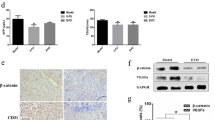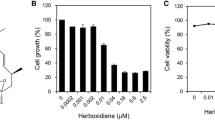ABSTRACT
Purpose
To investigate whether galbanic acid (GBA) exerts anti-angiogenic and anti-cancer activities.
Methods
Using human umbilical vein endothelial cell (HUVEC) model, we analyzed effects of GBA on cellular and molecular events related to angiogenesis. We tested its direct anti-proliferative action on mouse Lewis lung cancer (LLC) cells and established its in vivo anti-angiogenic and anti-tumor efficacy using LLC model.
Results
GBA significantly decreased vascular endothelial growth factor (VEGF)-induced proliferation and inhibited VEGF-induced migration and tube formation of HUVECs. These effects were accompanied by decreased phosphorylation of p38-mitogen-activated protein kinase (MAPK), c-jun N-terminal kinase (JNK), and AKT, and decreased expression of VEGFR targets endothelial nitric oxide synthase (eNOS) and cyclin D1 in VEGF-treated HUVECs. GBA also decreased LLC proliferation with an apparent G2/M arrest, but did not induce apoptosis. In vivo, inclusion of GBA in Matrigel plugs reduced VEGF-induced angiogenesis in mice. Galbanic acid given by daily i.p. injection (1 mg/kg) inhibited LLC-induced angiogenesis in an intradermal inoculation model and inhibited the growth of s.c. inoculated LLC allograft in syngenic mice. Immunohistochemistry revealed decreased CD34 microvessel density index and Ki-67 proliferative index in GBA-treated tumors.
Conclusions
GBA exerts anti-cancer activity in association with anti-angiogenic and anti-proliferative actions.







Similar content being viewed by others
REFERENCES
Folkman J. Angiogenesis in cancer, vascular, rheumatoid and other disease. Nat Med. 1995;1(1):27–31.
Hanahan D, Folkman J. Patterns and emerging mechanisms of the angiogenic switch during tumorigenesis. Cell. 1996;86(3):353–64.
Carmeliet P, Jain RK. Angiogenesis in cancer and other diseases. Nature. 2000;407(6801):249–57.
Folkman J. Fundamental concepts of the angiogenic process. Curr Mol Med. 2003;3(7):643–51.
Krupinski J, Stroemer P, Slevin M, Marti E, Kumar P, Rubio F. Three-dimensional structure and survival of newly formed blood vessels after focal cerebral ischemia. NeuroReport. 2003;14(8):1171–6.
Slevin M, Krupinski J, Kumar P, Gaffney J, Kumar S. Gene activation and protein expression following ischaemic stroke: strategies towards neuroprotection. J Cell Mol Med. 2005;9(1):85–102.
Slevin M, Kumar P, Gaffney J, Kumar S, Krupinski J. Can angiogenesis be exploited to improve stroke outcome? Mechanisms and therapeutic potential. Clin Sci (Lond). 2006;111(3):171–83.
Tosetti F, Ferrari N, De Flora S, Albini A. Angioprevention’: angiogenesis is a common and key target for cancer chemopreventive agents. FASEB J. 2002;16(1):2–14.
El Sayed KA. Natural products as angiogenesis modulators. Mini Rev Med Chem. 2005;5(11):971–93.
Ellis LM, Hicklin DJ. VEGF-targeted therapy: mechanisms of anti-tumour activity. Nat Rev Cancer. 2008;8(8):579–91.
Abd El-Razek MH, Ohta S, Ahmed AA, Hirata T. Sesquiterpene coumarins from the roots of Ferula assa-foetida. Phytochemistry. 2001;58(8):1289–95.
Lee JH, Choi S, Lee Y, et al. Herbal compound farnesiferol C exerts antiangiogenic and antitumor activity and targets multiple aspects of VEGFR1 (Flt1) or VEGFR2 (Flk1) signaling cascades. Mol Cancer Ther. 2010;9(2):389–99.
Lee SG, Ryu SY, Ahn JW. Reinvestigation of the structure of galbanic acid by 2D NMR techniques including 2D inadequate. Bull Korean Chem Soc. 1998;19(3):384–6.
Mansurov MM, Martirosov MS. Effect of the sodium salt of galbanic acid on thrombocyte aggregation. Farmakol Toksikol. 1988;51(1):47–8.
Bobek V, Kovarik J. Antitumor and antimetastatic effect of warfarin and heparins. Biomed Pharmacother. 2004;58(4):213–9.
Nakashima T, Hirano S, Agata N, et al. Inhibition of angiogenesis by a new isocoumarin, NM-3. J Antibiot (Tokyo). 1999;52(4):426–8.
Nam NH, Kim Y, You YJ, Hong DH, Kim HM, Ahn BZ. New constituents from Crinum latifolium with inhibitory effects against tube-like formation of human umbilical venous endothelial cells. Nat Prod Res. 2004;18(6):485–91.
Carmeliet P. VEGF as a key mediator of angiogenesis in cancer. Oncology. 2005;69 Suppl 3:4–10.
Kowanetz M, Ferrara N. Vascular endothelial growth factor signaling pathways: therapeutic perspective. Clin Cancer Res. 2006;12(17):5018–22.
Jaffe EA, Nachman RL, Becker CG, Minick CR. Culture of human endothelial cells derived from umbilical veins. Identification by morphologic and immunologic criteria. J Clin Invest. 1973;52(11):2745–56.
Huh JE, Lee EO, Kim MS, et al. Penta-O-galloyl-beta-D-glucose suppresses tumor growth via inhibition of angiogenesis and stimulation of apoptosis: roles of cyclooxygenase-2 and mitogen-activated protein kinase pathways. Carcinogenesis. 2005;26(8):1436–45.
Jost LM, Kirkwood JM, Whiteside TL. Improved short- and long-term XTT-based colorimetric cellular cytotoxicity assay for melanoma and other tumor cells. J Immunol Methods. 1992;147(2):153–65.
Grant DS, Kinsella JL, Fridman R, et al. Interaction of endothelial cells with a laminin A chain peptide (SIKVAV) in vitro and induction of angiogenic behavior in vivo. J Cell Physiol. 1992;153(3):614–25.
Lee HJ, Lee EO, Rhee YH, et al. An oriental herbal cocktail, ka-mi-kae-kyuk-tang, exerts anti-cancer activities by targeting angiogenesis, apoptosis and metastasis. Carcinogenesis. 2006;27(12):2455–63.
Passaniti A, Taylor RM, Pili R, et al. A simple, quantitative method for assessing angiogenesis and antiangiogenic agents using reconstituted basement membrane, heparin, and fibroblast growth factor. Laboratory investigation; a journal of technical methods and pathology. 1992;67(4):519–28.
Alessandri G, Filippeschi S, Sinibaldi P, et al. Influence of gangliosides on primary and metastatic neoplastic growth in human and murine cells. Cancer Res. 1987;47(16):4243–7.
Giavazzi R, Campbell DE, Jessup JM, Cleary K, Fidler IJ. Metastatic behavior of tumor cells isolated from primary and metastatic human colorectal carcinomas implanted into different sites in nude mice. Cancer Res. 1986;46(4 Pt 2):1928–33.
Eigner D, Scholz D. Ferula asa-foetida and Curcuma longa in traditional medical treatment and diet in Nepal. J Ethnopharmacol. 1999;67(1):1–6.
Garg DK, Banerjea AC, Verna J. The role of intestinal Clostidia and the effect of asafetida (Hing) and alcohol in flatulence. Indian J Microbiol. 1980;20(3):194–7.
Mallikarjuna GU, Dhanalakshmi S, Raisuddin S, Rao AR. Chemomodulatory influence of Ferula asafoetida on mammary epithelial differentiation, hepatic drug metabolizing enzymes, antioxidant profiles and N-methyl-N-nitrosourea-induced mammary carcinogenesis in rats. Breast Cancer Res Treat. 2003;81(1):1–10.
Unnikrishnan MC, Kuttan R. Tumour reducing and anticarcinogenic activity of selected spices. Cancer Lett. 1990;51(1):85–9.
Mansurov MM. Effect of Ferula asafetida on the blood coagulability. Med Zh Uzb. 1967;1967(6):46–9.
Rahlfs VW, Mossinger P. Asa foetida in the treatment of the irritable colon: a double-blind trial (author’s transl). Dtsch Med Wochenschr. 1979;104(4):140–3.
Soni KB, Rajan A, Kuttan R. Inhibition of aflatoxin-induced liver damage in ducklings by food additives. Mycotoxin Res. 1993;9(1):22–7.
Roberts PJ, Der CJ. Targeting the Raf-MEK-ERK mitogen-activated protein kinase cascade for the treatment of cancer. Oncogene. 2007;26(22):3291–310.
Depeille PE, Ding Y, Bromberg-White JL, Duesbery NS. MKK signaling and vascularization. Oncogene. 2007;26(9):1290–6.
Murphy DA, Makonnen S, Lassoued W, Feldman MD, Carter C, Lee WM. Inhibition of tumor endothelial ERK activation, angiogenesis, and tumor growth by sorafenib (BAY43-9006). Am J Pathol. 2006;169(5):1875–85.
Bissery MC, Guenard D, Gueritte-Voegelein F, Lavelle F. Experimental antitumor activity of taxotere (RP 56976, NSC 628503), a taxol analogue. Cancer Res. 1991;51(18):4845–52.
ACKNOWLEDGMENTS
This work was supported by Medical Research Center (MRC) grant (No. 2009-0063466) (S.H. Kim) and Hormel Foundation and NIH grant CA136953 (J. Lu). All authors declare no personal or financial conflict of interests.
Author information
Authors and Affiliations
Corresponding authors
Rights and permissions
About this article
Cite this article
Kim, KH., Lee, HJ., Jeong, SJ. et al. Galbanic Acid Isolated from Ferula assafoetida Exerts In Vivo Anti-tumor Activity in Association with Anti-angiogenesis and Anti-proliferation. Pharm Res 28, 597–609 (2011). https://doi.org/10.1007/s11095-010-0311-7
Received:
Accepted:
Published:
Issue Date:
DOI: https://doi.org/10.1007/s11095-010-0311-7




